On steamy summer afternoons, the aroma of chocolate fudge, peanut butter fudge or maybe caramel-smothered cashew brittle mingles in the seaside air in downtown Edgartown. It seeps out of 21 North Water street to sweeten the stale sidewalk air cocooning the VTA bus drop-off two blocks westward. Using the nose as a compass, vacationers and Islanders, like bloodhounds, sniff a path down Main street to meet the cause of the saliva swelling about their tongues: the mixing tables of Murdick’s Fudge shop, where fudge makers mold slabs of fudge and brittle crunch into melt-in-your-mouth morsels.
Time after time customers enter with the words: “Ever since we got off the bus we’ve been chasing this smell.”
Armed with thumb-sized samples of warm homemade fudge, general manager Mike McCourt lures visitors in with one moist chocolate bite. Then they’re hooked. A Murdick’s sales associate reels them in to the display case, and before long, the cash register.
While customers savor and shop, fudge specialist Mr. McCourt continues about his work — mixing, cooling and shaping mounds of fresh chocolate into five-foot-long loaves. When a 30-pound slab of fudge, “like a big Twix bar,” is precisely set, the 54-year-old Edgartown resident, fingers specked with brown batter, slices it into about 60 pieces to be wrapped and sold for a retail price of $7.95.
But on Saturday, Murdick’s Fudge will celebrate 30 years of business on the Vineyard — and these half-pound cakes of chocolate fudge will go for a smile to the first 420 customers at each Edgartown, Oak Bluffs and Vineyard Haven store. That’s $10,000 worth of free, fresh fudge.
Five years ago, on the shop’s 25th anniversary, Murdick’s Fudge first began the celebratory fudge giveaway. A hoard of fudge-hungry customers clustered outside the Edgartown shop before the special 11 a.m. opening time. With the passing minutes the line grew, snaking around Kelley street — almost to Dock street. “People line up because when it’s gone, it’s gone,” Mr. McCourt says.
Tomorrow the fudge is free, but it’s more than a good deal that draws a crowd to Murdick’s. The all-natural ingredients, 122-year-old recipe, rich and creamy taste and friendly fudge makers entice more than 60,000 customers to purchase Murdick’s brand fudge each eight-month season. “The thing about all our products is that [they are] basic,” explains Mr. McCourt, adjusting two wings of grey hair that jet out from under his khaki company cap. “We’re not trying to take fudge to the next level. It’s just fudge the way it should be. It’s the best fudge you can get.”
Murdick’s Fudge was established in 1887 on Mackinac Island in Michigan. Ninety-two years later, then and current owner Bob Benser brought the Murdick’s brand and fudge-making technique to Martha’s Vineyard. He purchased a building vacated by the Edgartown post office and opened the Island’s first branch in 1979. Satellite shops opened in Oak Bluffs in 1981 and Vineyard Haven the following year. The three Vineyard fudgeries have served more than two million customers in the past 30 years.
“There are 13 fudge shops [in Mackinac Island] on the strip from the yacht club on Main street to the triangle,” Mr. McCourt says of the fudge culture that the five original Murdick’s shops helped establish on the Great Lakes isle. “If it’s not the fudge capital of the world, I don’t know what is ... everyone who goes to Mackinac Island does three things: they ride a boat, they take a carriage ride around town and they buy fudge. We’re trying to get that trend going around here.”
On the Vineyard, the shelves of the three town shops are full of fudge in 12 varieties: vanilla, vanilla pecan, butter pecan, penuche, chocolate, double chocolate, chocolate peanut butter, chocolate pecan, chocolate walnut, peanut butter, rocky road and Cape Cod cranberry. Plain chocolate is the most profitable flavor, Mr. McCourt says.
Peanut butter fudge, Mr. McCourt’s favorite type, is prepared from a homemade blend of pure peanut butter and powdered sugar. He likens the chocolate peanut butter fudge, also made with this mix, to a “super Reese’s.” Two shots of Ocean Spray cranberry concentrate flavor each batch of Cape Cod cranberry fudge. Mr. McCourt travels to the Ocean Spray headquarters in Middleboro, Mass., at the start of each season to collect five gallons of cranberry concentrate for this regionally inspired fudge. “I’m guessing that a couple shots of that would probably make four or five gallons of cranberry juice — it’s that potent.”
The three shops also make boxes of sweet and crunchy peanut brittle and cashew brittle.
On a “making day,” each store prepares twelve 30-pound batches of fudge. These batches begin as one-gallon mixtures of light and heavy cream. Mr. McCourt boils the cream in a large copper cauldron. (Though tight-lipped on the company recipe, Mr. McCourt hints that the cream is more than 16 per cent butter fat — a smidge more than the percentage in Häagen-Dazs ice cream.) To this piping cauldron he adds white sugar, corn syrup, nulomoline, salt and chocolate. The copper container distributes heat evenly, preventing the fudge mix from burning. The boiling point of fudge varies with each batch. The mixture usually begins bubbling at 240-degrees. “You have to be within a half-degree [of the boiling point] or it will mess with the texture,” Mr. McCourt says. “If you overcook it, it’s too hard. If you undercook it, it won’t settle.”
Once the fudge begins to boil, Mr. McCourt pours it onto a 500-pound rectangular marble slab. The fudge sizzles like oil on a frying pan when it drops and spreads onto the table. In seconds, a layer of thick, brown glop covers the surface of the slab. Marble naturally regulates the heating and cooling of the fudge. It absorbs and stores heat from the fudge, which helps maintain the chocolate’s warmth and pliability. It simultaneously works to lengthen the cooling process; this keeps the fudge smooth and creamy. Fudge that cools too quickly loses its velvety texture and becomes granular.
On the morning of a fudge-making day, the slabs are cold. Mr. McCourt mixes the vanilla-based fudges first. These lighter fudges begin to heat the slab. When the marble reaches 90 degrees, Mr. McCourt can begin to mix and mold chocolate fudge. By afternoon, the tables will have reached 120 degrees. This temperature is hot enough to shape and cool peanut and cashew brittle. The heat is imperative to slowing the cooling process so that the candy makers can stretch the brittle before it hardens.
Sometimes, on busy summer days, the tables overheat. When this happens, a fudge maker must flee the shop to fetch ice cubes from Town Provision. The table must be cooled to a manageable temperature — otherwise, the fudge won’t harden.
Once the fudge is poured on a properly heated slab, Mr. McCourt grips a paint scraper-like tool called a fudge paddle and, pacing in circles around the table, whips the rigid blade through the liquid fudge. The motion of stirring helps to cool and thicken the fudge. Four stainless steel bars border the tabletop to prevent fudge from dripping onto the floor. When the fudge begins to solidify, Mr. McCourt pulls the bars away, scraping sticky chocolate sludge off the edges with a knife and adding it to the mass. Then he begins to mold a loaf. He trades the hand-sized fudge paddle for the larger fudge spade, which functions as an electric mixer. As he mixes and pushes the thickening chocolate toward the center of the slab, a long stick shape begins to solidify. Mr. McCourt uses a pliable version of the fudge paddle used earlier to whip the cake into precise form. A chocolate residue pools at the edges of the paddle and drips in decorative ribbons lined diagonally atop the mass of fudge.
From mixing bowl to solidified loaf, the time-sensitive fudge-making process lasts for 10 to 12 minutes.
“I’ve been making [fudge] for 16 years and there’s always new things I learn every year,” Mr. McCourt says. After bantering about the horse pie-like appearance of fudge with a customer who hails from Michigan, near Mr. McCourt’s hometown, he adds, “It’s all timing. If I tried to push this into a loaf [prematurely] it would get grainy. You learn to look for things in the fudge. The longer you make it, the better you get.”
Yet even a master fudge-maker like Mr. McCourt sometimes botches a batch. He recalls a slipup a few years ago: “We try to have fun while we’re doing this — and people are talking to us ... so I’m making a rocky road and the next thing I know, I look up, and there’s a full bag of marshmallows in front of me. I forgot to put them in. So what do you do with that?” Well, Mr. McCourt decided to temporarily add a new flavor to the fudge menu. That day, when a customer ordered rocky road fudge from the Edgartown shop, a sales associate would ask “with or without marshmallows?” The entire batch quickly sold.
The biggest hurdle, though, arises after the loaf has been mixed and molded. The most difficult part of the fudge making process, Mr. McCourt says, is dividing the loaf into uniform half-pound slices. It’s a skill that develops with practice. Novice fudge makers weigh every five or 10 slices they cut.
“Just because a person worked in a kitchen all his life ... doesn’t mean they can come in here and make fudge,” Mr. McCourt says. “It’s totally different. I can see a chef coming in here and murdering the fudge.” And though fudge-making is a tedious and time-sensitive process, Mr. McCourt says anyone can be trained to do it.
Mr. McCourt’s right-hand fudge maker, 23-year-old South African native Sivuyile Gaji, mixed, molded and sliced his first fudge batch soon after arriving on the Vineyard in April. The Murdick’s Fudge fledgling has grown to be the quickest fudge technician Mr. McCourt has ever hired.
As Mr. Gaji molds a batch himself, Mr. McCourt looks on like a proud papa. Customers watch, too, entranced by the buttery smell of fresh fudge batter. “It’s quite a show to make fudge in the window,” Mr. McCourt says.
One spectator is a little blond-haired boy. Peeking over the miniature white fence that divides the store from the kitchen, the wide-eyed boy ogles the spectacle of fudge-making. A saleswoman tucks the string of a white Murdick’s Fudge balloon into his palm. The boy hardly takes notice, for he is absorbed by the glossy brown melt being slopped by Mr. Gaji. When the loaf is set, Mr. McCourt passes squares of fudge to the boy and his family. The bite-sized cake of chocolate dissolves in the boy’s mouth. His closed lips spread into a smile. The boy’s mother, fingering a brochure of flavors, approaches the display counter.
“The saying ‘The more you make, the more you sell; the more you sell, the more you make’ — it fits us,” Mr. McCourt says.

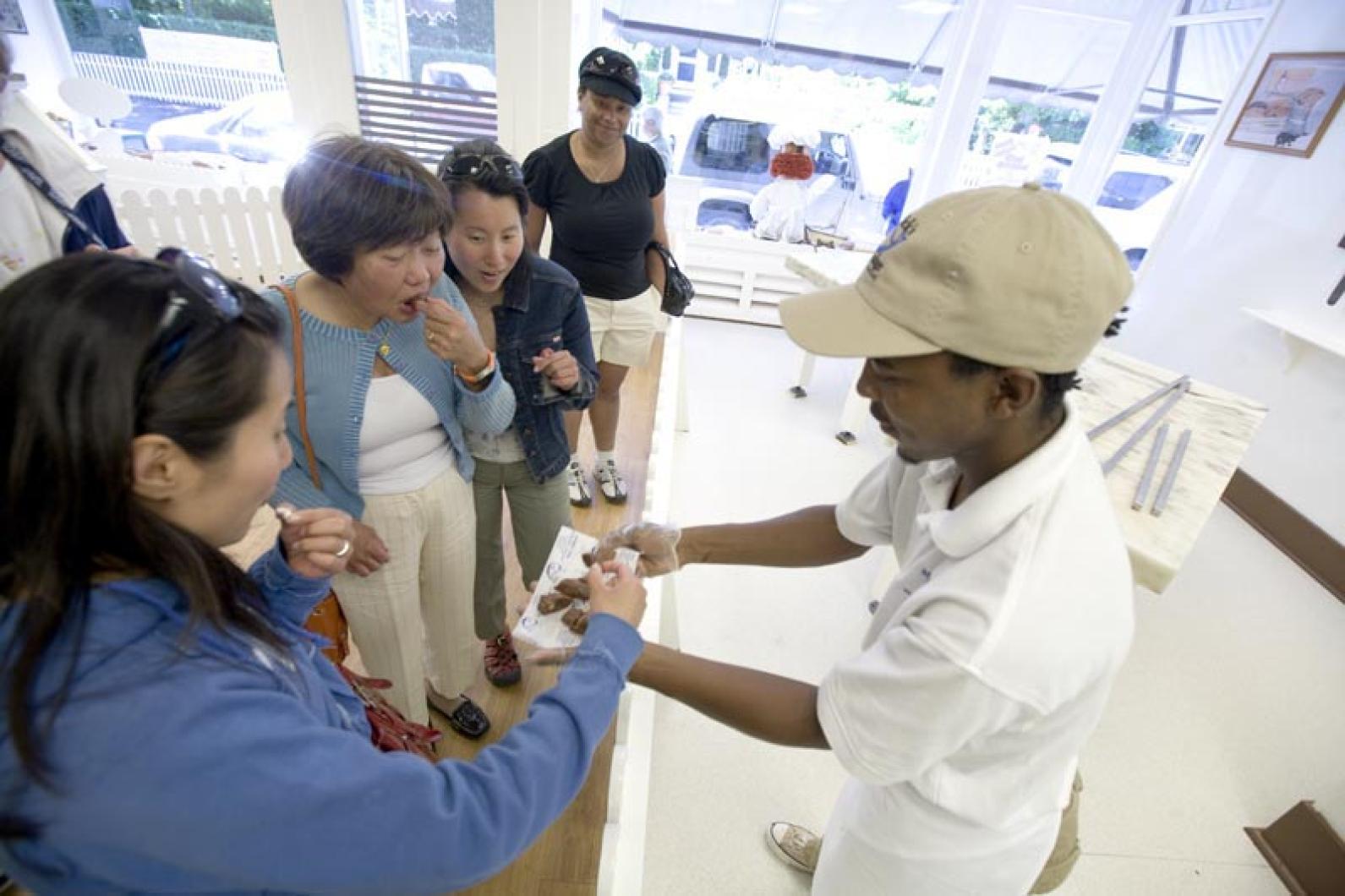
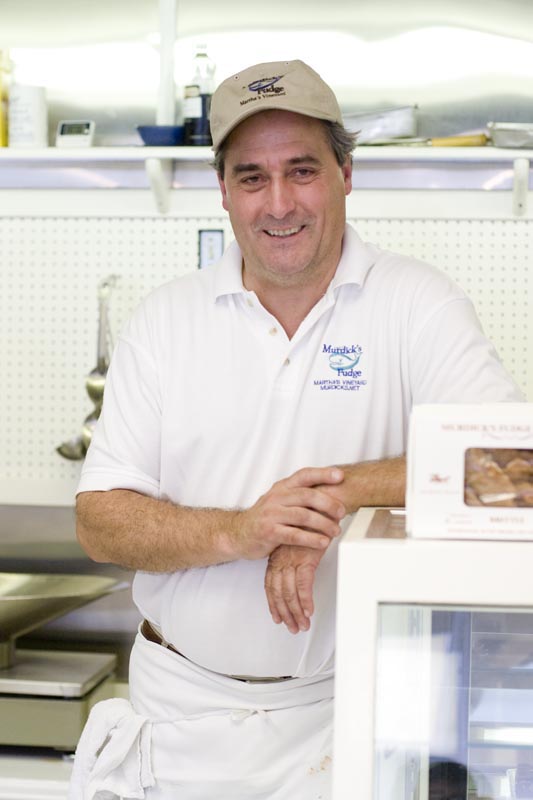
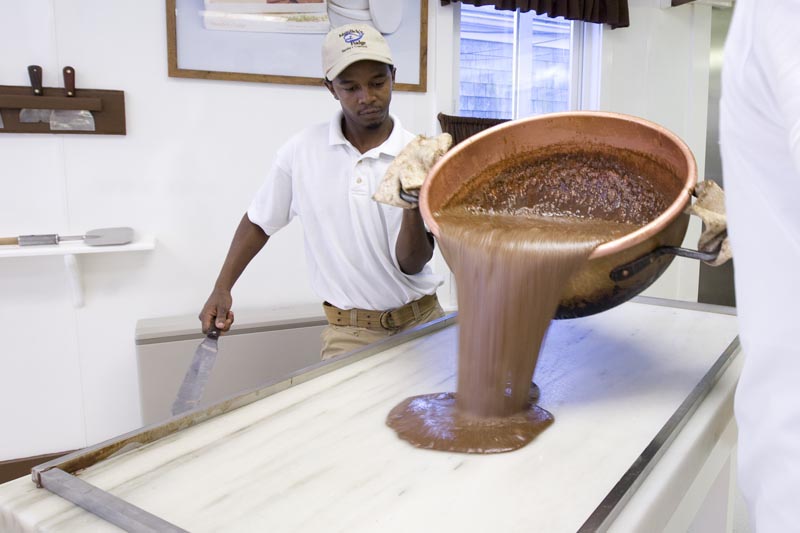
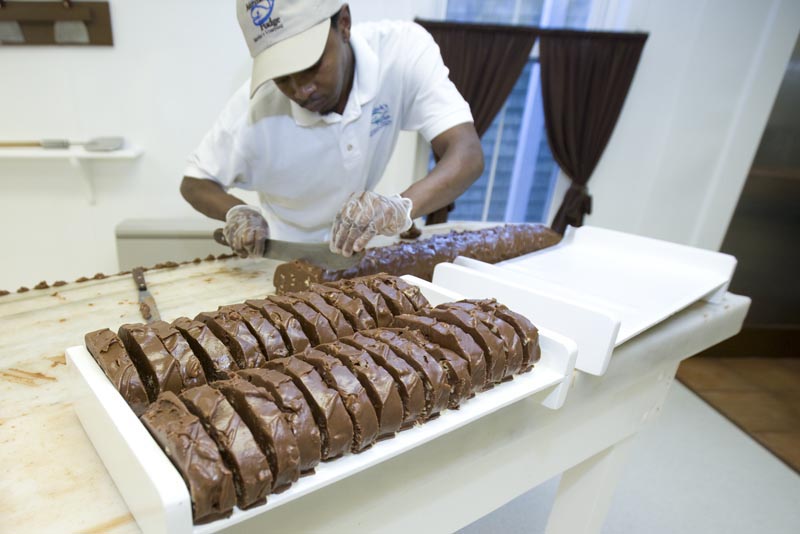
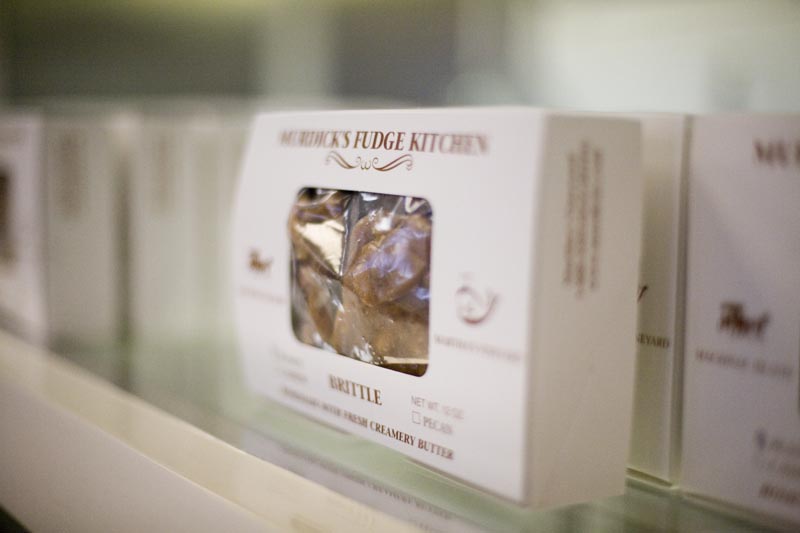




Comments
Comment policy »